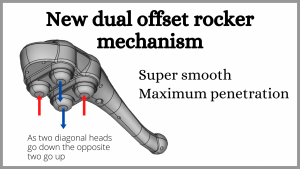Low back pain: chiropractic, physio, massage, exercise or drugs
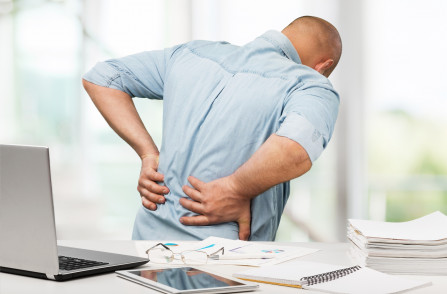
There are many different treatments for back pain. Should you see a chiropractor, get a massage, exercise or take drugs? To understand what you need we need to look at what causes back pain and how each treatment can contribute to fixing the problem.
CONTENTS
Basic spinal anatomy
The fundamental problem: stiffened spinal joints
What happens when a spinal joint stiffens
Treatment of lower back problems
How movement is restored
Putting it all together
Professionals
References
The cause of back pain and how it’s fixed
The causes of back pain can be extremely complex, but we can simplify it by looking at a basic core problem and how other problems develop from there. This will help give a clear direction on what needs to be done to take care of your own problem. To do this we will:
- briefly go over the parts of your spine and how they should work
- what goes wrong with your spine, and
- how each treatment helps remedy it.
Basic spinal anatomy
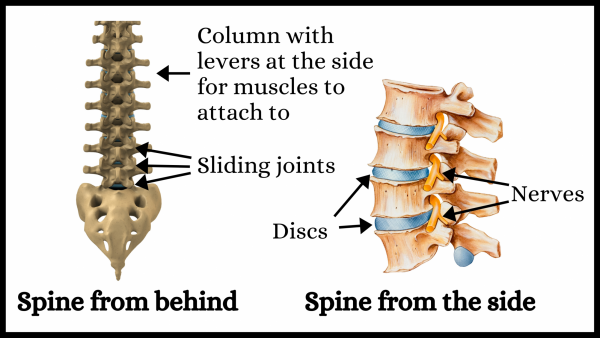
- Your spine has a column of bones (vertebrae) that support your weight
- When you move each joint moves a bit so the movement is distributed between all the joints
- Between each of the vertebrae is i) a disc that is flexible enough to allow a small movement, and ii) two small sliding joints that guide the movement.
- Muscles attach to the levers. It is their pull that balances and moves your spine.
- Nerves come out each side between the vertebrae.
The fundamental problem: stiffened spinal joints
For a spine to work normally each joint needs to be able to move freely. Problems arise when individual joints stiffen losing their ability to move freely, and often “sit” slightly out of balance. In 27+ years as a chiropractor every patient with back pain had at least one of these, and often many. Causes of these stiffened joints include:
- injury (single or repeated)
- prolonged abnormal posture
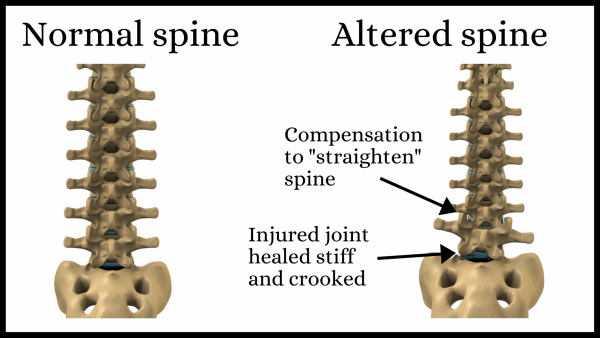
What happens when spinal joints stiffen
In this diagram we can see a normal spine on the left, while the spine on the right has a stiffened joint. The bottom vertebrae is sitting slightly tilted to the right, while the stiffening will not allow it to move to the left.
They are not bones out of place
Because it is not sitting in it's normal neutral position these are (wrongly) called "bones out of place", but they are really moving parts that are not able to move freely.
What happens when a spinal joint stiffens
These diagrams show some of the fundamental things that happen when these joints stiffen.
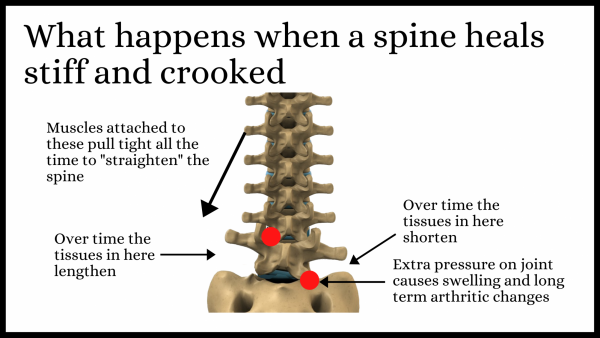
Tension on muscles to maintain balance
The tilting vertebrae will tend to lean the spine above to the right. The muscles on the opposite side will need to tighten to straighten and balance the spine. This continued tension on the muscles will cause muscular problems and pain.
Abnormal pressure on joints
As you can see, with the tilt on the bottom vertebrae a lot of extra pressure is placed on the small joint at the bottom right. This causes:
- irritation and inflammation of the joint
- makes the joint more prone to being injured
- increases wear in the joint, causing long term degenerative (arthritic) changes.
You can also see a similar thing is happening to the joint above on the left because that joint is tilting back the opposite way to compensate.
Overloading other joints
Movement is normally evenly distributed through all the joints, but when one joint is stiffened other joints are forced to move more. It is usually the adjoining joint that takes the brunt of this. Spinal surgeons recognise that when joints are fused (surgically fixed) the adjoining joint usually develops problems a few years later (1).
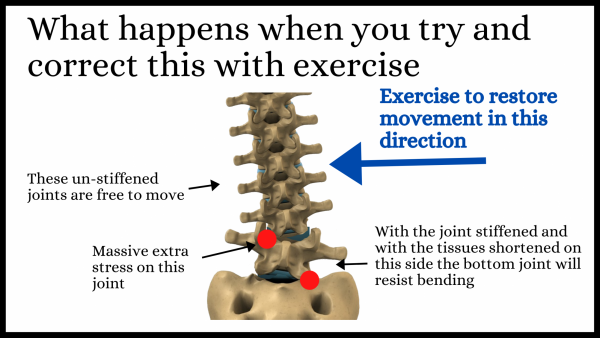
In this diagram we see what happens when attempting to bend the spine with the stiffened lower joint to the left. The lower joint is stiff and stays fixed to the right while the ones above are forced to move excessively to compensate.
Changes in muscles and other tissues
As a previous diagram showed the space between the levers on the lower right side of the vertebrae is now small, whereas it is much larger on the left. Over time the muscles and ligaments between these physically change in length. For the joint to return to normal these tissues would need to change back again.
Nerves
When a vertebrae tilts to the side the space for the nerve to come out is reduced. This space can be further reduced by any swelling.
Discs
The easiest way to picture a disc is to think of it as like a car tire sitting between the vertebrae, only it is filled with jelly rather than air. The walls of the discs have enough flexibility to allow each vertebrae to move a few degrees.
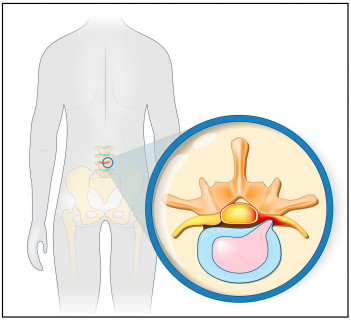
Over time repeated bending and twisting can weaken this casing allowing it to bulge outwards. This is known as a disc injury or a ruptured disc. How are disc injuries and stiffened joints related?
- The damaged disc may cause the joint to tilt or stiffen, or
- the abnormal stress caused by a stiffened joint (eg at the compensating joint above) can stress and weaken a disc causing it to rupture.
When a disc ruptures:
- the injury may be painful,
- it may cause a joint to tilt and stiffen, and
- the bulge may press on a nerve.
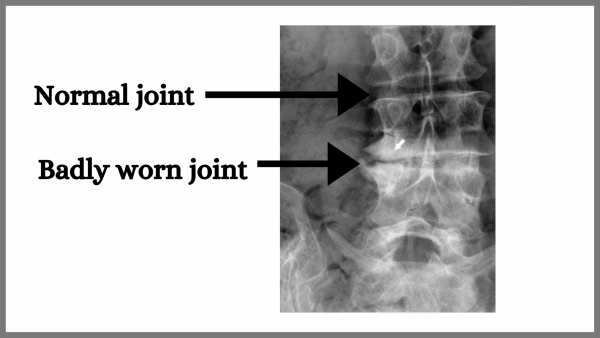
Arthritic changes (not old age)
Arthritic changes are often wrongly attributed to old age. As this x/ray shows they are really caused by abnormal mechanical stress over a long period of time. The x/ray shows one joint has badly deteriorated while the one above looks in excellent condition. The badly worn joint will have been affected by the abnormal stresses. The normal joint (same age) will not have been.
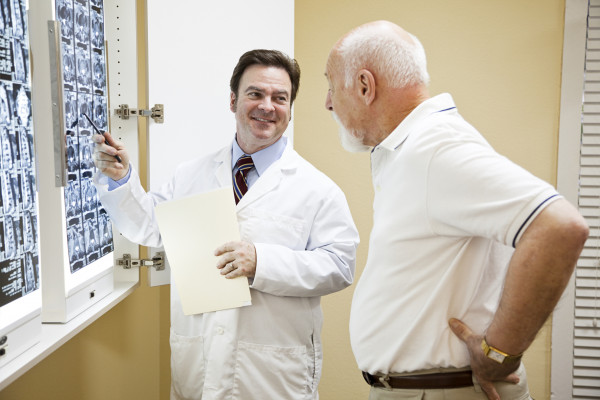
Summary
These effects show how the various parts of a low back problem fit together. We’ve seen how stiffened joints can be caused by disc injuries and other issues so there can be some discussion about what causes what. However, once the joint has stiffened that becomes academic. The stiffened joint and all the other effects need to be dealt with. To summarise this, stiffened spinal joints cause the following problems, and by the time your back becomes painful usually most need to be considered.
- abnormal tension in muscles
- abnormal pressure on the joints at the rear of the spine
- abnormal stress in compensating joints
- long term changes in muscles and other tissues
- pressure on nerves
- disc injuries
- arthritic changes.
Treatment of lower back problems
At the start of this article I said that we need to look at the cause of low back problems and how each of the therapies can help fix these problems. We may not know what caused what originally. However, stiffened joints are universally present. For treatment purposes it is simple to think of them as a central issue and the rest as secondary problems that also need to be dealt with. To illustrate why these are central please consider what would happen if the movement of these joints was restored, then compare this to what happens when they are ignored and therapies are applied to the other issues.

What happens when movement of stiffened joints is restored
Consider what would happen if the stiffened joint were able to move freely again and be able to rest in it’s correct balanced position.
- The muscles would no longer need to be tight to balance the spine above.
- The abnormal pressure on the small joints would be removed
- Compensating joints would no longer need to do the extra work.
- There would be more room for nerves to pass through
- If there was arthritic changes because of prolonged abnormal stress removing that pressure may relieve the symptoms.
As you can see this would go a long way towards remedying the problem.
What happens when only therapies are applied
Too often we see back pain treated by applying therapies to the secondary issues. Examples include massage for tight muscles or anti-inflammatory drugs for the inflamed joints. However, when a joint remains stiffened and “sitting” out of balance:
- the muscles will remain tight to re-balance the spine
- there will still be abnormal pressure on the joints
- the over-stressed compensating joints still need to compensate.
Because of this therapies such as massage, drugs or needles can only give short term relief. The problem will remain.
How movement is restored

The wrong way to restore movement
We often see exercises alone prescribed to restore normal spinal movement. We have seen before in this diagram that when the bottom joint was stiffened to the right any exercise bending to the left would not move the stiffened joint, but rather movement would be produced by over stressing the joints above. Exercises may temporarily produce some extra movement, but this will be at the expense of over stressing the already over stressed joints above. Long term the stiffened joint will stay stiff while the joint above will likely eventually develop arthritic changes or be severely injured.
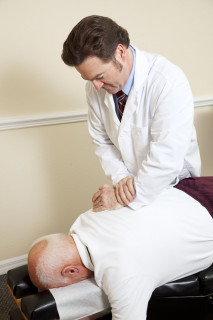
The correct way to restore movement
The key to restoring movement to these stiffened joints is by using very specific and highly accurate force directed just at that joint (6–9). This is the core expertise of chiropractors who call this maneuver an adjustment. Others such as Osteopaths and therapists with special post graduate qualifications have expertise at this as well, and use different terminology.
Combining these with other therapies
Due to the changes in muscles and other tissues these procedures need to be repeated many times and supported by other therapies. It needs someone with the the appropriate skill and training, such as the aforementioned professionals, to determine what is needed. However, below is a summary of how each of the various therapies for back pain may help.
Massage
We’ve seen that muscles and other tissues can tighten and physically change. Apart from becoming painful in their own right these restrict the movement and posture from returning to normal. Massage is a very useful therapy to help restore muscles to their normal health.
Exercise
We have seen that exercises alone will not restore normal movement. However, as movement is restored to the stiffened joints exercises can be gradually introduced to help those joints restore to normal.
Medication
Medication may be used to help settle down things like badly inflamed joints. However, using them to relieve pain or reduce inflammation without consideration of why the pain or inflammation occurs will never fix anything, and only masks the symptoms allowing further damage and deterioration.
Surgery
Surgery may be needed if a back problem is allowed to deteriorate until either a joint is totally beyond being functionally restored or a ruptured disc is pressing on a nerve. The key thing to understand though is that if this does happen, after the surgery all those non surgical issues will still remain.
Putting it all together
The headline of this article said “chiropractic, physio, massage, exercise or drugs”. As we’ve seen remedying these spinal issues needs several therapies combined with the specific goal to restore your spine to as normal as possible. The aforementioned professionals will have excellent training in all of those aspects. Even if they choose to have other professionals help (such as referring to a massage therapist) they will know what is needed and will be able to advise you.
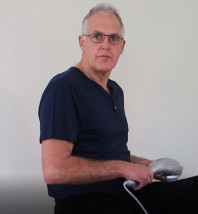
Graeme’s comments
Although chiropractic adjustments and the like can give instant relief the muscles and other soft tissues associated with stiffened joints take time to re-adapt and strengthen. Without this any improvements are usually short lived. To restore the movement of stiffened joints it needs repeated adjustments (or similar) over time supported by a lot of soft tissue therapy (massage) and exercise. This is the reason I built our massagers. They i) make it easier for patients to get the amount of therapy they need, and ii) allow for very specific therapy to muscles deep around the stiffened joints.
Enabling patients to get the massage they need
As discussed in our article Why do trigger points keep coming back treating muscular issues requires a lot of therapy such as massage over time. Having an effective machine patients could use for self massage made this a lot more convenient and affordable.
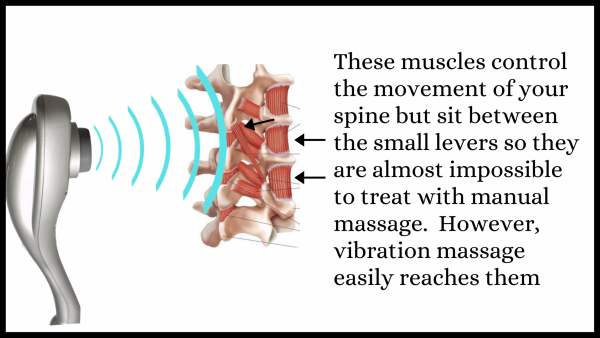
Getting at the small deep muscles
This diagram shows the important muscles that control the movement of individual joints. As you can see they are very deep between those levers at the side and back of the vertebrae. Because they are so deep and placed between bones they are practically impossible to massage using conventional manual massage. However, if you sit the head of a vibration massager directly over these muscles the vibrations will penetrate and “massage” them very effectively.
How to choose a vibration massager
For how to choose an quality massager that will do a great job and that you will be extremely happy with please see our article How to choose a massager, or you can go straight and check out our economical, easy to use professional standard machines: the General Purpose Massager or our Ultimate Quad Head Massager.
Professionals
DrGraeme massagers were originally built by Dr Graeme for use in his clinic, and to prescribe to his patients for additional self use at home. Now these are used by colleagues and other professionals for similar purposes. If you are a professional and wish to know more about this therapy, or possibly get a sample massager to trial please check out our practitioner page.
References
- Stokes, I. Iatridis J. Mechanical conditions that accelerate intervertebral disc: Overload Versus Immobilization. Spine 2004;29(23):2724–32.
- Saunders HD. Classification of Musculoskeletal Spinal Conditions. J Orthop Sport Phys Ther. 1979;1(1):3–15.
- Jaumard N V., Welch WC, Winkelstein BA. Spinal facet joint biomechanics and mechanotransduction in normal, injury and degenerative conditions. J Biomech Eng. 2011;133(7):1–31.
- Merlo JA. Onset, location, and progression of facet joint articular cartilage degeneration following lumbar spinal hypomobility. ProQuest Diss Theses. 2016;30:118.
- Cramer GD, Fournier JT, Wolcott CC, Henderson CNR. Degenerative changes following spinal fixation in a small animal model. J Manipulative Physiol Ther. 2004;27(3):141–54.
- Clealand J et. al. Short-term effects of thrust versus nonthrust mobilisation/manipulation at the thoracic spine in patients with neck pain: a randomised clinical trial. Phys Ther. 2007;87(4):431–40.
- Lau HMC, Wing Chiu TT, Lam TH. The effectiveness of thoracic manipulation on patients with chronic mechanical neck pain - A randomized controlled trial. Man Ther. 2011;16(2):141–7.
- González-Iglesias J, Fernández-De-Las-Peñas C, Cleland JA, Gutiérrez-Vega MDR. Thoracic spine manipulation for the management of patients with neck pain: A randomized clinical trial. J Orthop Sports Phys Ther. 2009;39(1):20–7.
- Krauss J, Creighton D, Ely JD, Podlewska-Ely J. The immediate effects of upper thoracic translatoric spinal manipulation on cervical pain and range of motion: A randomized clinical trial. J Man Manip Ther. 2008;16(2):93–9.
We are continually adding more information on research and uses. Subscribe below to have us email them to you "hot off the press".

About Dr Graeme
Several years ago Dr Graeme, a Chiropractor practicing in Victoria, Australia was looking for a serious hand held massager his patients could use at home to get the extra quality massage they needed. The ones he found in the shops and on-line for home use looked nice but were not serious, and... read more

